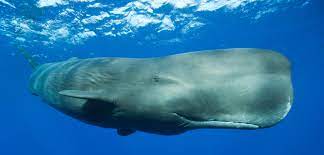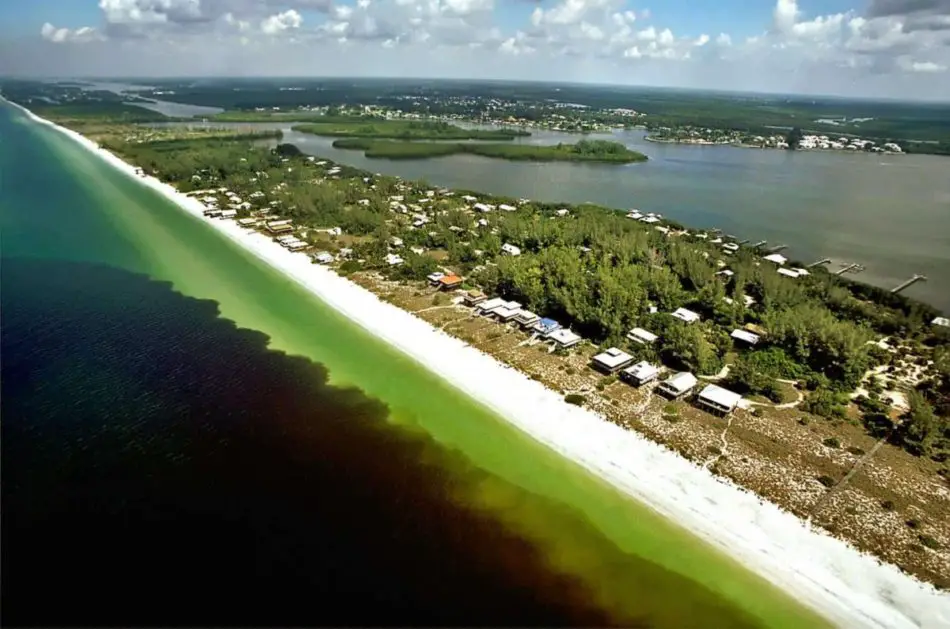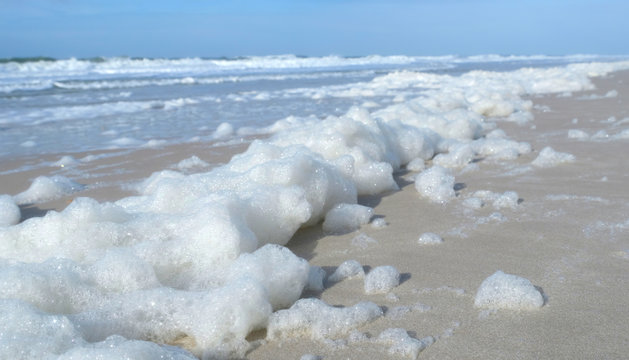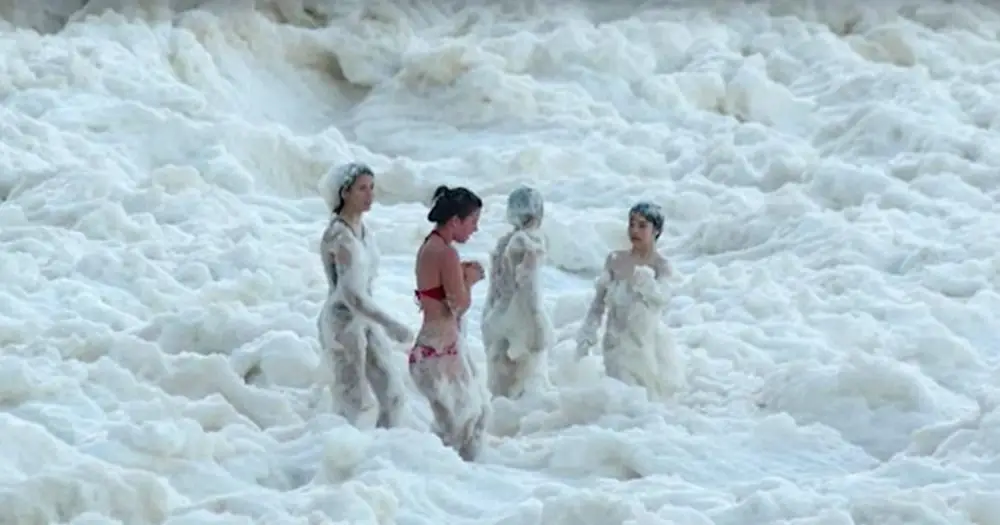One of the funniest stories I heard in a while had to do with Sea Foaming that is occurring throughout the world, with some places getting more than their fair share. Blowing up from the beach onto the street in coastal towns blocking traffic and causing a stir with people speculating what this foam is made from, the weirdest explanation being that it had something to do with the sperm of a whale. Is Sea Foam Wale Sperm?
No, Sea Foam is not whale sperm. Sea Foam created by the agitation of sea H2O contains high concentrations of dissolved organic matter, including proteins, lignins & lipids derived from sources such as the offshore breakdown of algal blooms. These compounds can act as surfactants or foaming agents.
In places like Southeast Queen’s Land Australia Seafoam has become more than a natural occurrence at certain times of the year. The foaming from their coastal towns has made its way from the surf to the beach to inside city streets, where this global phenomenon has become worrisome to its residents because of the Seafoam’s origin and ingredients.
Introduction:
Strolling along the shoreline, you may have encountered the frothy blankets of sea foam that hug the coast, sparking curiosity and folklore alike. One particularly enduring myth suggests that this oceanic foam is whale sperm, an idea that has floated through conversations with both humor and bewilderment. In this article, we’ll dive into the origins of sea foam and unravel the scientific truths behind its formation, effectively dispelling myths and providing clarity to a natural phenomenon often shrouded in maritime lore
Is Sea Foam Whale Sperm

No, sea foam is not whale sperm. The misconception that sea foam contains whale sperm is a myth. Sea foam is created through natural processes in the ocean, primarily due to the breakdown of organic matter.
It consists of:
- dissolved organic compounds
- proteins
- substances that get agitated by waves, forming a frothy mixture
- inorganic matter like dissolved sea salts
The foam that washes ashore is a result of this natural phenomenon, and it has no connection to whale sperm. Sea water is full of tiny particle that is organic and some inorganic matter like dissolved sea salts, proteins, fats, dead algae, detergents, and other pollutants, and a bunch of other bits and pieces of organic and artificial matter.
You just can’t see it unless you are studying it up close or you take a sample and shake it up. When that material that collects in the ocean hits the surf, it churns up, presenting itself as bubbles and foam. Most people don’t believe the Whale story, at least at the Jersey shore where I’m from.
Water and foam on some beaches and surf are more agitated than others, and the foaming problem that happens all over the world might be more prevalent in one area because of the wind, currents, and rougher surf.
The Foam is made up of Algae Blooms that are found in freshwater and saltwater sea that contribute to foaming. Nutrients and organic material that floats on the surface of water get mixed up by wind and tides and end up on the beach.
Sea Foam: Unraveling the Ocean’s Myths About Foam Whale and Sperm Foam
Sea foam has long been a source of intrigue, giving rise to various myths and legends surrounding its existence. One common misconception is that sea foam is whale sperm. However, this is entirely false, as sea foam is a natural occurrence caused by the breakdown of organic matter in the ocean.
It is primarily composed of dissolved organic compounds, proteins, and other substances, not whale sperm. The foam forms when waves agitate the water, creating a frothy mixture that washes ashore. Understanding the scientific explanation behind sea foam dispels the mythical associations often linked to this natural phenomenon.
According to the (NOAA which) is The National Oceanic and Atmospheric Association: Most sea foam is not harmful to humans and is often an indication of a productive ocean ecosystem. But when large harmful algal blooms decay near shore, there are potential for impacts to human health and the environment. Along Gulf coast beaches during blooms of Karenia brevis, for example, popping sea foam bubbles are one way that algal toxins become airborne.
The resulting aerosol can irritate the eyes of beach goers and poses a health risk for those with asthma or other respiratory conditions. Scientists studying the cause of a seabird die-offs off California in 2007 and in the Pacific Northwest in 2009 also found a soap-like foam from a decaying Akashiwo sanguinea algae bloom had removed the waterproofing on feathers, making it harder for birds to fly. This led to the onset of fatal hypothermia in many birds.
So with excessive Seafoam, there are some environmental hazards associated with it, but mostly the dangers are unknown. It is known that Sea Foam contains ingredients of proteins, lignins, and lipids derived from sources such as the offshore breakdown of algal blooms.
These compounds can act as surfactants or foaming agents, and the more they contain and the more agitated the water, the more foam is produced by some animals and human and fish waste. Not Whale sperm it’s a natural occurrence that has nothing to do with whale juice.
It is actually called Sea Foam a common occurrence, made in the sea and coastal communities. The Sea mystery is solved concerning what is Seafoam also called Ocean foam. Essentially Sea Foam is totally natural and is not a big event compared to other bigger natural occurrences. Sea Foam might contain pollution or contaminants from Sewer or Stormwater drains that are in the vicinity of the blankets of Sea Foam that are accumulated and end up on the beach.
When observing the vast expanse of blue waters churning out a white froth along the shoreline, many are quick to question, “Is sea foam whale sperm?” The answer is a resounding no; it’s not whale sperm. This misconception may stem from the ocean’s mystery and our fascination with its inhabitants, especially the magnificent whale.
But sea foam is a natural marine phenomenon, far from being linked to any single animal’s reproductive process. Sea foam forms when seawater is agitated by wind and waves. It’s a cocktail of organic material, including proteins and dead cells from sea creatures, not just whales, stirred together to create those bubbly patches that crown the ocean with a fleeting, frothy ornamentation.
Ambergris, a substance produced by sperm whales, is often mixed up with sea foam due to its waxy nature and occasional appearance on sea shores. However, while ambergris is indeed related to whales, sea foam is not; they are distinctly different oceanic features. Sea foam can envelop beaches in a white blanket, transforming the coastal scene into a picturesque spectacle.
Sea Foam or Ocean Foam is a global phenomenon containing dissolved organic & inorganic proteins, fats, dead algae, detergents, & other pollutants, that act as a surfactant, or foaming agent, which, combined with the pounding of ocean waves, results in large buildups of foam ..…………………………………………………….. Read more
Is Blue Whales Sperm Foam Harmful Algal Blooms (HABs)
Blue whales’ sperm has no connection to Harmful Algal Blooms (HABs). Harmful Algal Blooms are caused by the rapid growth of specific types of algae, which can produce toxins harmful to marine life and humans. While whale activity may contribute nutrients to the ocean, linking blue whale sperm to HABs is not scientifically accurate.

Another global ocean phenomenon called Harmful Algae Blooms (HABs) can occur in all types of seawater HABs are a major coastal environmental problem in all 50 states. Red tides, blue-green algae, and cyanobacteria are examples of harmful algal blooms that can have severe impacts on human health, ocean aquatic ecosystems, and the economy.
Harmful Algae Blooms (HABs) can have various negative impacts on aquatic ecosystems and public health. Here’s a short list of potential consequences associated with HABs:
- Toxin Production: HABs can produce toxins harmful to marine life, causing illness or death to fish and other organisms.
- Shellfish Contamination: Filter-feeding shellfish can accumulate algal toxins, posing a risk to human consumers if contaminated shellfish are consumed.
- Fish Kills: Some HABs can lead to large-scale fish kills as a result of oxygen depletion or the direct toxic effects of algal blooms.
- Economic Impact: HABs can have economic repercussions, affecting fisheries, aquaculture, and tourism industries due to the potential closure of affected areas.
- Human Health Risks: Inhaling or coming into contact with aerosolized toxins from HABs can lead to respiratory and skin issues in humans.
- Disruption of Ecosystems: HABs can disrupt the balance of marine ecosystems, impacting various species and their interactions.
Monitoring and managing HABs are essential to mitigate these adverse effects and protect both the environment and human health.
Sea Foam is not a Harmful algal bloom it’s a natural occurrence in the sea that has nothing to do with whale juice. Sea Foam is the overgrowth of algae in the water. Some algae blooms produce dangerous toxins in fresh or marine water, but even nontoxic blooms in seawater hurt the environment and local economies.
They are mostly caused by Nutrients (nitrogen and phosphorus) along with temperature, Sunlight, and Slow-moving water. Sea Foam is made in oceans close to the coast from pollution.
The NOAA monitors HABs algal blooms, sometimes known as “red tide,” which occur when certain kinds of algae grow very quickly, forming patches, or “blooms,” in the water. These blooms can emit powerful toxins which endanger human and animal health.
Sea Foam, called ocean & beach foam, is caused by high concentrations of dissolved organic matter from algae blooms, detergents & ocean pollutants derived from sources offshore churned up by wind & waves creating agitation of the air, H2O, & a compound called surfactant .……………………………………………………. Read more
Ocean Whale Sperm Foam Size
Incredible enough, Whales have some of the smallest sperm of all mammals. They vary from 50-75 microns, whereas human sperm is 40-90 microns long.

It is thought that whales have such small sperm because the female reproductive tract is so large that having longer sperm doesn’t give a male any extra advantage.
A Blue ocean whale delivers up to 5 gallons of semen at a time and up to 30-40 gallons of whale’s sperm made. The Blue Whale’s sperm most of the time the sperm foam is washed out of the female into the ocean.
Whale sperm produce ambergris taken from the ocean is used in medicine. Ambergris is made from Sperm Whale’s body and is considered very valuable.
Just a drop in the bucket in the ocean, Yes, I found it on Google.
According to Trevor Branch, a blue whale researcher at the University of Washington, told Buzz Feed News.
In my humble opinion, If whale sperm is so small and the amount in an ocean is minimal at best, it’s kind of counterproductive to the opinion that Sea Foam is made up of whale sperm. Sea foam is a worldwide phenomenon, and how bad the foam gets depends on its location in the ocean and the potential influence of the surrounding marine, freshwater, and/or terrestrial environments. Due to its low density and persistence, foam can be blown by strong ocean shore winds from the beach that face inland and can cause some trouble, if not fascination, to coastal dwellers filling city streets with foam blankets.
Most Sea Foam is not harmful, is not whale sperm, and is often a sign of a healthy ecosystem. Still, when large healthy alga blooms decay too close to shore, they have the potential for a negative impact on human health and the environment.
In Conclusion:
Sea foam or Ocean Foam is not whale sperm. Sea foam is a worldwide phenomenon created by the agitation of sea H2O contains high concentrations of dissolved organic matter, by high concentrations of dissolved organic matter from algae blooms, detergents & ocean pollutants derived from sources offshore churned up by wind & waves creating agitation of the air, H2O, & a compound called surfactant.
Is Sea Foam Good for the Environment?
Yes, Sea Foam can play a number of ecological roles & can actually show a natural & healthy marine environment by acting
As a habitat for organisms
As a food source for aquatic plants
As a mode of transport for both organisms & nutrients …………………………………………………………………………………….Read more

References:
Deep-Sea News-Attack of the Sea Foam, It’s Not Whale Sperm
A: Sea foam is a natural marine phenomenon that forms when seawater, containing a mix of organic material like proteins and dead cells from sea creatures, is agitated by wind and waves. The churning water whips these materials into the frothy, whitish substance seen along coastlines.
Q: Is sea foam made of whale sperm?
A: No, sea foam is not made of whale sperm. This is a myth that has been debunked by scientific understanding. Sea foam consists of a cocktail of organic matter, including proteins, dead plant materials, and other oceanic detritus, but it is not connected to any animal’s reproductive process.
Q: Why do some people think sea foam is whale sperm?
A: The misconception may stem from the ocean’s mystery and our fascination with its creatures, especially tales surrounding whales. The misnaming of sperm whales, which were thought to have spermiceti (a waxy substance) as sperm, contributes to the confusion. Additionally, social media platforms and digital folklore perpetuate this myth by sharing false information.
Q: What purpose does sea foam serve in the ocean environment?
A: Sea foam plays a part in redistributing nutrients among marine animals and plants. It is formed from organic matter that, when agitated and frothed up, can envelope beaches and aid in nutrient cycling, benefiting the coastal ecosystem.
Q: Can sea foam be related to any human activity?
A: Sea foam can include components from both natural and human-made sources. Human activities that contribute nutrients or pollutants to the ocean can affect the composition and quantity of sea foam seen in coastal areas.
